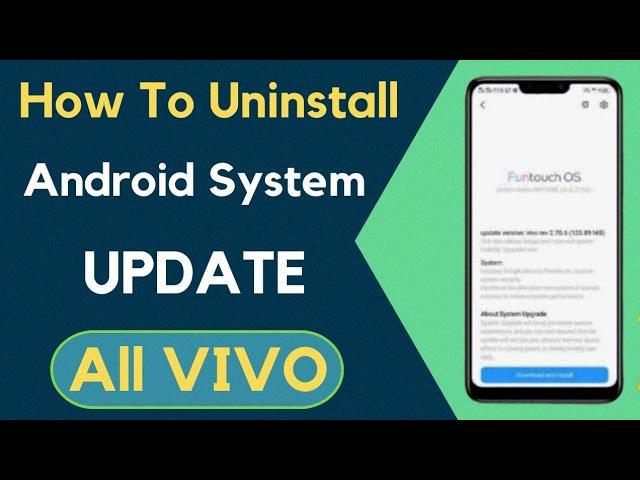Uninstalling an Android update can be a frustrating task, as once the updates are downloaded and installed on your device, rolling back the action is not possible. It is important to note that Android updates are managed by the device manufacturer, and unfortunately, there is no option to uninstall an update that has already been installed.
However, if you wish to revert to the previous version of the Android operating system, there are a couple of options available. One option is to perform a factory reset on your phone. This will erase all data and settings on your device, effectively bringing it back to its original state when you first received it. It is crucial to back up any important data before proceeding with a factory reset, as this process will wipe everything from your device.
To perform a factory reset, go to the Settings menu on your Android device. Look for the “Backup & Reset” or “System” section, where you will find the option to reset your device to its factory settings. Keep in mind that the exact location of these options may vary depending on the Android version and device model you have.
Another option to revert to a previous Android version is by flashing a factory image. This method is more advanced and should only be attempted if you have technical knowledge or are comfortable following detailed instructions. Flashing a factory image involves downloading the specific Android version you want to install, connecting your device to a computer, and using special software to install the image on your device. This process will also wipe all data on your device, so it is crucial to back up any important information beforehand.
It is important to note that both the factory reset and flashing a factory image methods will remove all data from your device. Therefore, it is recommended to back up any important files, contacts, or other data before proceeding with either of these methods.
Uninstalling an Android update and reverting to a previous version of the operating system is not a straightforward process. It requires either performing a factory reset or flashing a factory image, both of which will erase all data on your device. It is essential to proceed with caution and back up any important data beforehand.
Can I Undo The Latest Android Update?
It is not possible to undo the latest Android update once it has been downloaded and installed on your device. Once the update is completed, it permanently replaces the previous version of the operating system on your Android device.
Here are a few key points to note about Android updates:
1. Device Manufacturer Control: Android updates are managed and released by the device manufacturer, such as Samsung, Google, or Huawei. They are responsible for providing the updates to their devices.
2. No Official Rollback Option: Unfortunately, there is no official method provided by the device manufacturers to rollback or revert to a previous Android version once you have installed an update. Once the update is installed, it becomes the new base version of the operating system on your device.
3. Backup Considerations: It is always recommended to back up your important data, files, and settings before performing any major update. This way, if any issues arise after the update, you can restore your device to its previous state using the backup.
4. User Modifications: If you have rooted or modified your Android device, installing an official update may cause issues or even lead to a bricked device. It is important to understand the risks involved in modifying your device and to follow proper procedures for updating.
Once you have installed the latest Android update, it cannot be undone or rolled back. It is important to consider the potential impact of an update and ensure you have a backup of your data before proceeding with any major system updates.

Can I Get Rid Of Android 12 Update?
It is not possible to uninstall or revert back to a previous version of Android after updating to Android 12. Once you have installed the update, you cannot simply remove it or downgrade to a lower version of the operating system. The update process is designed to be a one-way process, with no built-in option to go back to an earlier version.
If you are not satisfied with Android 12 or experiencing issues with it, your best option would be to perform a factory reset on your device. This will erase all data and settings on your phone, essentially returning it to its original state when you first purchased it. However, it is important to note that this will result in the loss of all your data, so it is crucial to backup any important information before proceeding with a factory reset.
Alternatively, if you are technically inclined and have the necessary knowledge, you can consider flashing a factory image of a previous Android version onto your device. This process can be complicated and risky, and it is typically recommended for advanced users or developers. It involves manually installing an older version of the operating system onto your phone, effectively overwriting the current Android 12 installation. However, this process requires specific software, firmware, and a thorough understanding of the flashing process, so proceed with caution and ensure you have the correct resources and guidance before attempting it.
While it is not possible to directly uninstall the Android 12 update, you can either perform a factory reset or flash a factory image of a previous Android version if you wish to revert back to an earlier operating system.
Conclusion
Once an Android update is downloaded and installed on your device, there is no straightforward way to uninstall or roll back the update. This is because Android updates are managed by the device manufacturer, and they do not provide an option to revert to a previous version of the operating system.
If you really want to go back to the previous version of the Android operating system, you would need to perform a factory reset on your device. This process will erase all data and settings on your phone, essentially returning it to its original state when you first purchased it.
Another option is to flash a factory image onto your device. This involves manually installing a specific version of the Android operating system onto your device. However, this process can be complex and risky, as it requires technical knowledge and may void your device’s warranty.
It is important to note that uninstalling an Android update is not a recommended solution unless you have a specific reason to do so. Updates often include important security patches, bug fixes, and new features that enhance the performance and functionality of your device. It is generally advisable to keep your device up to date with the latest software updates provided by the manufacturer to ensure optimal performance and security.







